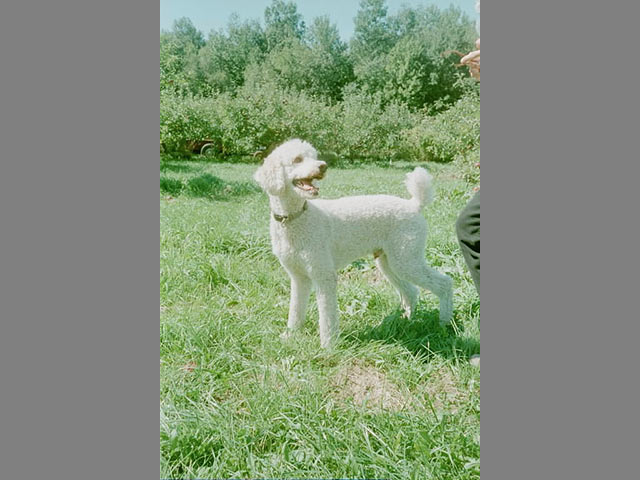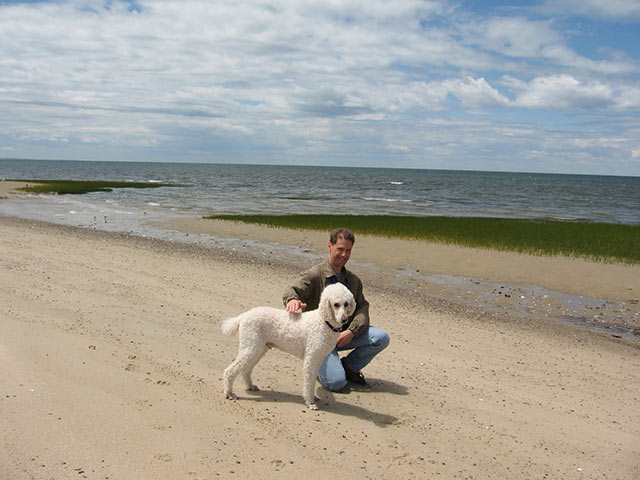Kramer's Battle





Beginning of the End
The blood test results were the stuff of every dog owner's nightmares. Dr. Paporello informed us that "Kramer's liver enzymes are through the roof," ten times normal level. She believed Kramer was experiencing acute liver failure, and ordered X-rays of his abdomen. X-rays would not offer an absolute diagnosis. For that, Kramer would need a biopsy, a surgical procedure to remove a portion of his liver. Another option, a "fine-needle biopsy," allows the tester to take a liver sample without surgery, but is far less conclusive. In the first of many confusing decisions, we chose to save Kramer from surgery, opting for the less invasive test.
The fine-needle biopsy was inconclusive, but the X-ray showed abnormalities in Kramer's liver. We were prescribed Denamarin, a drug famed for re-building liver tissue. In just two days, Ellen and I transitioned from living happily with Kramer to poring over Internet searches on "canine liver failure."
Facing Reality
The plan was to treat Kramer for a couple of days, then do more testing. The danger signs were lethargy, loss of appetite, and vomiting. Sure enough, over the next couple of days Kramer lost interest in food. Was this appetite loss, or just a response to medications? We were told, after all, that antibiotics could cause a stomach upset, and Kramer always had a sensitive stomach.
His energy level dropped. Did this truly constitute "lethargy," or just a dampening of Kramer's bouncy personality?
Kramer was waking up in the middle of the night desperate to urinate. We would race down the stairs, hoping to make it outside.
Ellen and I continued asking ourselves how to respond to all of this. We returned for follow-up liver tests. We walked Kramer all the way to and from the veterinary clinic, and even stopped to greet passers by. How could this dog be deathly ill?
More blood tests, more bad results. The medications were not working. Kramer's liver enzymes were climbing ever higher.
Over the next couple of days, we struggled to get Kramer to eat anything. We cooked chicken and fed him small pieces. How could things change so suddenly, barely a week after that first test?
Then came the sign we feared most. Kramer began vomiting.
Two Words Change Everything
We reported the vomiting to Dr. Paporello, and asked what to do next. Her response was firm. "This is a terminal case. At this point, I'd suggest comfort measures." Dr. Paporello's clinic could offer no further treatment. Instead, she coordinated an immediate transfer to the local emergency clinic to stabilize him and clarify the diagnosis.
We took this as an affront. Kramer was still friendly to guests, still following us around the house, still happy to be with us. How could our veterinarian be so sure it was time to give up?
Ellen and I put on Kramer's leash for "one last walk around the block" before we headed for the clinic.
Conflicting Prognosis, Frail Hopes
At the Veterinary Emergency and Specialty Hospital, in South Deerfield, MA, we met with the chief of staff, Dr. Kirsten Losert, DVM. She listened as we told her what had happened so far, then she offered a plan. They would get Kramer on IV fluids, pump anti-vomiting compounds into his body and intravenously deliver liver medications. They would run tests to pinpoint exactly what was wrong with his liver. We would receive phone updates each morning and evening.
Resolved to face reality, Ellen asked, "Are we going to put him through all this and lose him anyway?"
We were ready to hear Dr. Losert echo Dr. Paporello's prognosis. Instead, in answer to Ellen's question, she said, "Not necessarily."
With Dr. Paporello's contradictory advice still fresh on our minds, we agreed to the plan.
That night, a Monday, Dr. Losert reported that Kramer's liver enzymes continued climbing. I expected to hear that it was time to give up. But Dr. Losert suggested, "Let's give it another couple of days, to see what happens."
We approved continued treatment, and waited.
The phone rang on Tuesday morning. "I'm really worried about Kramer," Dr. Losert said. "He's still not eating, and he's very weak."
She said a visit from us might lift his spirits. We arrived with one of Kramer's favorite toys. He followed us outside the clinic, and we sat in the grassy lawn watching Kramer chew his stuffed animal.
Did Kramer look better or worse? Was he was still the same dog? Were we losing him? Our regular veterinarian had given up hope, and yet emergency experts were saying it was worthwhile to fight. That must mean he has a chance?
At the end of the visit, we handed the leash to an assistant and watched as Kramer was escorted away.
Wednesday morning, the update was more dire. Kramer's liver enzymes had climbed to 15 times normal. "He's just not responding to treatments," Dr. Losert explained.
"What would you suggest?" I asked.
I was prepared to hear that even the emergency clinic had run out of options. But Dr. Losert's answer was, "I think it's time to step up our treatments."
A String of Treatments
Three humans decided to take an aggressive treatment path. We could not consider giving up as long as there was any hope. Kramer was subject to our decisions, however wise or unwise.
"I'm going to suggest that we insert a feeding tube," Dr. Losert said. "While we have him there, we can also do a liver biopsy."
"If this was your dog, what would you do?" I asked.
Her response was encouraging. "Definitely, if this was my dog, I'd do it. I'd say his chances are 50/50."
A hard number sounded better than anything we had heard so far. Ellen and I approved the feeding-tube procedure for the next day. In the meantime, we visited Kramer again. By now, he had gone several days without food. He was weaker, yet still happy to see us as we lay together hugging him on the lawn.
Thursday's update came from the surgeon. The feeding-tube operation went well. He examined the liver visually, then gathered tissue samples to send out for testing. He also inserted a shunt to enhance bile flow between Kramer's gall bladder and intestines (this flow problem was a possible contributor to Kramer's condition).
That evening, Dr. Losert's report sounded too good to be true. "The goal is to have him home in a couple of days. With the feeding tube, you can feed him and medicate him yourself. It will get around his lack of appetite."
If the emergency veterinarians had thought it was hopeless, surely they would not recommend we do all this, and talk about Kramer coming home? And yet, we could not forget Dr. Paporello's words, "terminal" and "comfort measures only."
More Frustration
Kramer's illness marched on.
Ellen and I startled every time the phone rang, and my heart raced whenever I saw the emergency clinic's number on caller ID. On Friday morning, Dr. Losert's update was negative. Even with state-of-the-art surgery working for us, using procedures equivalent to those for humans, Kramer was vomiting, his energy level was dropping, and his liver enzymes continued their impossible ascent.
Once again, I asked, "What should we do?" Dr. Losert responded, "I'd give it a little more time. You never know, I've seen dogs turn around in cases like this."
Ellen and I were confused, but we now spoke clearly about when to override the emergency veterinarian's advice. Why such a difference of opinion between our regular veterinarian and the emergency clinic? But then, what if things could turn around?
Accepting the End
Saturday's update came from a different veterinarian (Dr. Losert was off duty). Kramer was getting even worse. They asked us to come in as soon as possible to discuss options.
We took that to mean that the struggle was over. Ellen was 40 weeks pregnant, and the mounting stress was too much, so I went to the clinic myself.
The whole drive there, I prepared to see Kramer, face whatever emotions would take control of me when I had to approve euthanasia. Unanswered questions turned over in my mind. Should I hold Kramer as it happened? What should I say? What would it be like afterwards?
We had been preparing for the end for several days. But how different it is when you are on your way to do it.
I entered the same hospital room where, five days earlier, we had our first consultation with Dr. Losert. When the veterinarian entered, I almost heard the words before they were spoken: it's time to put Kramer to sleep.
Instead, she asked me to observe Kramer's condition and tell her what I think.
Final Contact
Two assistants carried Kramer in on a stretcher, lowered him to the floor, then left. For a few seconds, I stood, taking it all in. The soft curls on Kramer's stomach had been shaved for surgery. Tubing sprouted from his body. There was the feeding tube, a hard plastic thing. Rubber bandages wrapped around his mid-section held the tubes in place. At the end of one tube was a bag collecting urine because he was too weak to stand.
I dropped onto the floor beside Kramer, hugged his head (one of the only parts of his body untouched by medical procedures). Kramer relaxed his head on my arms and I buried my nose in the soft, warm area behind his ear.
Running my hands through his curls, my mind drifted. At our local dog park, there was a route we took with Kramer, a winding path through woods, corn fields, up rocky hills, along a river. Together, Kramer and I went back in time, tracing an entire outing, free from physical limitations. There was Kramer prancing in the winter snow. There he was on a summer day splashing into the river after a tennis ball. There he was covered in mud at the end of all-out play, shaking himself off before we got into the car.
When I heard a gentle knock at the door, I looked up. It had been almost two hours.
"How does he seem to you?" the veterinarian asked.
"He's obviously not going to recover," I said. "There's not much for us to do, is there?"
Amazingly, she said, "We can hold out a little longer to see what happens."
Driving home, I wondered how to report this to Ellen, who was expecting the end. Instead, the three of us had to endure another chapter.
Kramer Makes it Easier
Ellen and I sat up late Saturday night, preparing ourselves to face euthanasia the next day.
Around 11:00 PM, the phone rang. At the other end, someone said that Kramer slipped into a coma just minutes earlier. This was the most peaceful thing that could happen. His mind was away from his surroundings. He no longer felt anything.
Then these words: "We usually recommend euthanasia in these situations."
Making Sense
Ellen and I have spent hours replaying this story.
Would it have been better to take Dr. Paporello's advice to keep Kramer comfortable, rather than put him through all that? None of the procedures we approved slowed the illness one bit. Was there ever truly hope that things could go differently?
Might we have asked more questions and challenged the veterinarians to better explain their advice? Could we have figured out the discrepancy between the advice of our regular veterinarian and emergency veterinarian?
The burden of being a dog lover is that we all eventually face such questions. It may help to spend time, while our dogs are healthy, to decide how far we will go. There are no right and wrong answers, only ones we can feel settled about afterwards.
